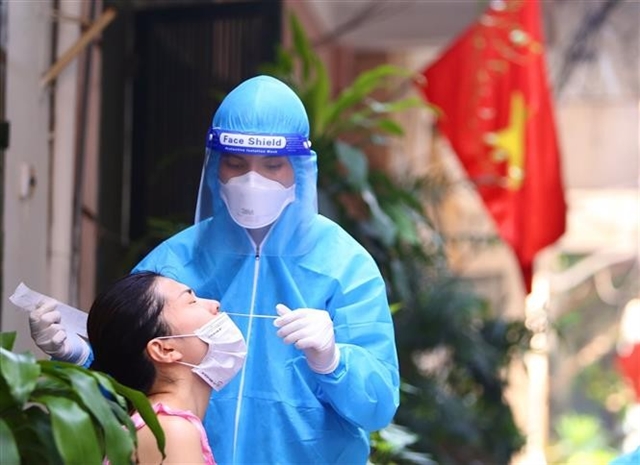 Society
Society


|
| A medical worker takes a sample for COVID-19 testing in Hà Nội's Bạch Mai Ward on September 12. — VNA/VNS Photo |
HÀ NỘI — People living in high risk or very high risk areas must be tested for SARS-CoV-2 three times a week, while those living in other areas tested every five or seven days.
This is part of the latest guidelines sent by the Ministry of Health to steering committees for COVID-19 prevention and control in provinces and cities nationwide on Tuesday. The guidelines concentrate on testing and preventive measures to take when localities implement social distancing.
According to the ministry, ramping up testing was important to control the disease. In areas with a high/very high risk of COVID-19 infection, rapid antigen tests should be given priority to immediately isolate positive cases.
Rapid antigen tests and RT-PCR tests could be combined.
In areas with less risk of infection, pooled testing can be used based on specific conditions, for example, combining testing samples from people of the same family, the same building or neighbours.
Under the guidelines, localities should arrange testing sites for small areas. Volunteers and people can help take samples for rapid antigen tests.
If unable to conduct mass testing, areas at high/very high risk must report to the national steering committee for COVID-19 prevention and control or ask for help from other areas.
The Health Ministry asked localities to set up and operate mobile healthcare stations based in communes/wards which have high/very high risks of infection. Schools, community houses and offices could be turned into a mobile healthcare stations so that people could access health services as soon as possible.
Communes, wards and towns that are under the 'new normal' stage must also prepare sites, medical equipment and staff to use in case their situation worsens.
Authorities must continuously evaluate COVID-19 risks to decide to impose social distancing measures or loosen the measures in specific areas. Social distancing measures must be loosened step by step while screening tests are maintained.
In the guidelines, the ministry emphasised that social distancing measures should be put in place in as-small-as-possible areas, for example, a hamlet, a residential group or a street.
The social distancing aims to stop infections and control the disease as soon as possible – within 14 days.
Social distancing measures must be implemented strictly. During social distancing, the supply of food and other essentials for affected people must be ensured. Medical measures like testing, treatment and vaccination must be conducted systematically. Measures are also needed to ensure that people can access health services early, at the grassroots level.
In the last few months, 23 provinces and cities in Việt Nam have implemented social distancing measures and stricter measures to control COVID-19.
Social distancing brought positive results in curbing COVID-19 infections.
However, in some localities, social distancing has been extended due to improper implementation of measures, a lack of detailed goals, scale and time to apply social distancing or insufficient testing.
According to the ministry, the COVID-19 pandemic is developing and may last for a long time, especially with the presence of the Delta variant which can spread much easier and faster than the original SARS-CoV-2 and other variants. — VNS